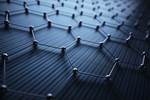University researchers produce new carbon allotrope with metallic properties
While atomically thin like graphene, the carbon network’s atoms form squares, hexagons and octagons in an ordered lattice and behaves like a metal, making it ideal for nanoscale carbon materials.

Structure of the new carbon network. The upper part schematically shows the linking of the carbon atoms, forming squares, hexagons, and octagons. The lower part is an image of the network, obtained with high resolution microscopy. Photo Credit: University of Marburg, Aalto University
Researchers at the University of Marburg (Germany) and Aalto University (Finland) have reported the recent discovery of a new carbon network —the Biphenylene network — which is atomically thin like graphene, but is made up of squares, hexagons and octagons forming an ordered lattice. Confirmed using high-resolution scanning probe microscopy, it was further noted that, unlike graphene and other forms of carbon, the new carbon allotrope retains metallic properties, offering novel opportunities to produce other theoretically-designed but not-yet-created forms of nanoscale carbon materials.
While graphene is a semiconductor at this size, researchers say narrow strips of the Biphenylene network, only 21 atoms wide, already behave like a metal. “These stripes could be used as conducting wires in future carbon-based electronic devices,” says Professor Michael Gottfried at University of Marburg, who leads the team who developed the idea.
The lead author of the study, Qitang Fan from Marburg continues, “This novel carbon network may also serve as a superior anode material in lithium-ion batteries, with a larger lithium storage capacity compared to that of the current graphene-based materials.”
The team at Aalto University helped image the material and decipher its properties. The group under Professor Peter Liljeroth carried out the high-resolution microscopy that showed the structure of the material, while researchers led by Professor Adam Foster used computer simulations and analysis to understand the material’s electrical properties.
According to the European team, the new material is made by assembling carbon-containing molecules on an extremely smooth gold surface. These molecules first form chains, which consist of linked hexagons, and a subsequent reaction connects these chains together to form the squares and octagons. An important feature of the chains is that they are chiral, which means that they exist in two mirroring types, like left and right hands. Only chains of the same type aggregate on the gold surface, forming well-ordered assemblies, before they connect. This is reportedly critical for the formation of the new carbon material, because the reaction between two different types of chains leads only to graphene. “The new idea is to use molecular precursors that are tweaked to yield biphenylene instead of graphene,” explains Linghao Yan, who carried out the high-resolution microscopy experiments at Aalto University.
For now, the teams work to produce larger sheets of the material, so that its application potential can be further explored. However, “We are confident that this new synthesis method will lead to the discovery of other novel carbon networks,” concludes Professor Liljeroth.
Original publication: Q.T. Fan, L.H. Yan, M.W. Tripp, O. Krejči, S. Dimosthenous, S.R. Kachel, M.Y. Chen, A.S. Foster, U. Koert, P. Liljeroth, J.M. Gottfried, Biphenylene Network: A Nonbenzenoid Carbon Allotrope, Science 372, (2021).
Related Content
-
New online training course targets prepreg basics
JEC World 2024: Composites Expert highlights how its E-Learning Composites Academy platform supports flexible industry learning with new courses developed with Stelia Aerospace North America.
-
Composites UK launches best practice guide for composites tooling
“Mould Tooling for Fibre-Reinforced Polymer Composites” is latest in Composites UK’s series of good practice guides, available online for free.
-
Toray, University of Chicago speed up polymer recycling R&D
A jointly developed multi-scale computational predictive technique can accurately predict viscoelasticity from the chemical structures of polymers, ramping up product maturation.
















